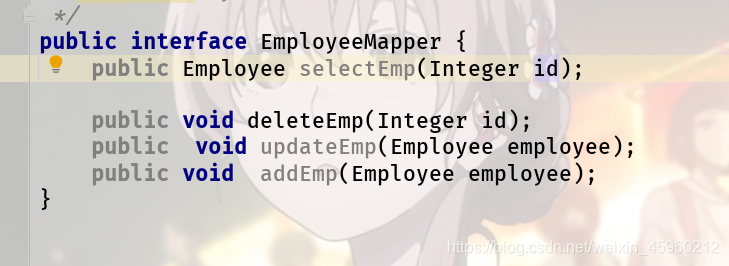Mabatis 增删改查
本文共 493 字,大约阅读时间需要 1 分钟。
目录
第一步 :编写对应的方法 和配置:
注意 id与接口的方法名一一对应

第二步:编写测试代码:

public SqlSessionFactory getsqlSessionFactory() throws IOException { String resource = "conf/mybatis-config.xml"; InputStream inputStream = Resources.getResourceAsStream(resource); SqlSessionFactory sqlSessionFactory = new SqlSessionFactoryBuilder().build(inputStream); return sqlSessionFactory; } 第三步 测试即可:
注意 增删改 (如果没设置的话) 需要手动提交!
sqlSession.commit();

转载地址:http://nhetz.baihongyu.com/
你可能感兴趣的文章
Nacos集群搭建
查看>>
nacos集群搭建
查看>>
nagios安装文档
查看>>
Navicat for MySQL 查看BLOB字段内容
查看>>
Neo4j电影关系图Cypher
查看>>
Neo4j的安装与使用
查看>>
Neo4j(2):环境搭建
查看>>
Neo私链
查看>>
nessus快速安装使用指南(非常详细)零基础入门到精通,收藏这一篇就够了
查看>>
Nessus漏洞扫描教程之配置Nessus
查看>>
Nest.js 6.0.0 正式版发布,基于 TypeScript 的 Node.js 框架
查看>>
nestJS学习
查看>>
Net 应用程序如何在32位操作系统下申请超过2G的内存
查看>>
NetApp凭借领先的混合云数据与服务把握数字化转型机遇
查看>>
NetBeans IDE8.0需要JDK1.7及以上版本
查看>>
netbeans生成的maven工程没有web.xml文件 如何新建
查看>>
netcat的端口转发功能的实现
查看>>
netfilter应用场景
查看>>
netlink2.6.32内核实现源码
查看>>
NetMizer-日志管理系统 dologin.php SQL注入漏洞复现(XVE-2024-37672)
查看>>